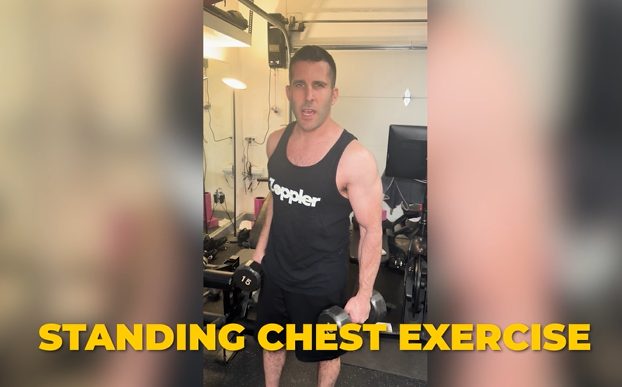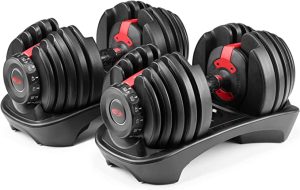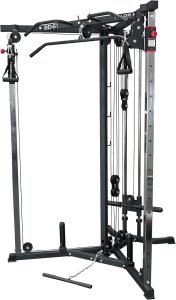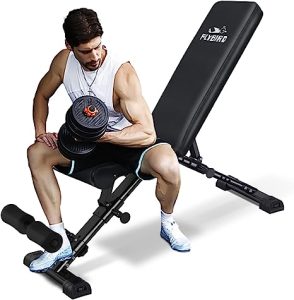Embark on a journey to redefine your chest workout routine as we dive into the world of standing chest exercises. Whether you’re tired of the same old bench press routine or simply looking for a change of pace, these exercises are here to revolutionize the way you sculpt and strengthen your chest muscles. Say goodbye to the confines of gym benches and hello to the freedom of movement that standing exercises provide. In this comprehensive guide, we’ll explore a variety of standing chest exercises that not only challenge your muscles but also add an exciting element to your fitness regimen. Get ready to elevate your chest workout experience and unlock a new level of strength and definition.
Whether you’re a seasoned gym-goer or just starting your fitness journey, these exercises are designed to be both effective and accessible. No bench? No problem! Get ready to feel the burn, engage your core, and witness the incredible results of incorporating standing chest exercises into your routine. Hit play, follow along, and let’s take your chest workout to the next level!
Below is a List of Standing Chest Exercises to Check Try Out
- Standing Chest Press: Stand with feet shoulder-width apart, hold dumbbells at shoulder height, and press them straight in front of you.
- Chest Fly with Resistance Bands: Secure a resistance band at chest height, stand facing away, and extend your arms forward in a flye motion.
- Standing Cable Crossover: Utilize cable machines to perform a crossover motion, engaging chest muscles by bringing hands together in front of your body.
- Dumbbell Pullover: Hold a dumbbell with both hands overhead and lower it behind your head, then pull it back up, engaging the chest.
- Bodyweight Standing Push-Ups: Stand facing a sturdy surface, lean forward, and perform standing push-ups by pressing against the surface.
- Standing Chest Squeeze: Hold a medicine ball or a similar object at chest height and squeeze it tightly, engaging chest muscles.
- Resistance Band Chest Press: Anchor a resistance band at chest level, hold the ends in each hand, and press forward, focusing on resistance.
- Dumbbell Front Raise: Lift dumbbells from your sides to shoulder height, maintaining a slight bend in the elbows to engage the chest.
- Medicine Ball Slams: Lift a medicine ball overhead and slam it forcefully to the ground, engaging chest and core muscles.
- Standing Isometric Chest Contraction: Stand with arms extended in front, press your palms together, and hold for an isometric contraction to target chest muscles.
- Underhand Front Chest Raises: Hold a dumbbell underhand in one hand and raise it up across your body. Alternate arms. This works your upper and inner chest mainly.
Remember to maintain proper form, control your movements, and adjust the resistance according to your fitness level. Always consult with a fitness professional or healthcare provider before starting a new exercise routine, especially if you have any pre-existing conditions or concerns.
Workout Equipment to Use for Standing Chest Exercises
1. Bowflex SelectTech 552 Adjustable Dumbbell Set
2. Valor Fitness Cable Machine
3. FLYBIRD Adjustable Weight Benches
The Advantages of Doing a Standing Chest Exercise
Incorporating standing chest exercises into your workout routine offers several advantages that can enhance your overall fitness experience. Here are some key benefits:
- Functional Strength: Standing chest exercises often mimic real-life movements, promoting functional strength that translates to better performance in daily activities.
- Engagement of Stabilizing Muscles: Standing exercises engage stabilizing muscles in the core, legs, and hips, promoting overall stability and balance during chest workouts.
- Versatility: You can perform standing chest exercises virtually anywhere, making them versatile and accessible for individuals who may not have access to gym equipment.
- Increased Caloric Burn: Engaging multiple muscle groups simultaneously, as is the case with standing exercises, can lead to increased calorie expenditure, supporting weight management and fat loss.
- Joint-Friendly: Standing exercises often involve natural joint movements, reducing the stress on joints that can occur with certain seated or lying down chest exercises.
- Improved Posture: Many standing chest exercises encourage proper posture, helping to strengthen the muscles that contribute to a more upright and aligned body position.
- Enhanced Range of Motion: Standing exercises may allow for a greater range of motion compared to some traditional chest exercises, contributing to improved flexibility and joint health.
- Variety and Challenge: Adding standing chest exercises to your routine introduces variety, preventing workout monotony and challenging your muscles in different ways.
- Convenience: No need for a bench or specialized equipment—standing chest exercises are convenient and can be easily integrated into your workout routine, whether at home or in the gym.
- Mind-Muscle Connection: Standing exercises often require greater focus on maintaining balance and control, fostering a stronger mind-muscle connection and promoting better neuromuscular coordination.
Remember to start with appropriate weights, maintain proper form, and gradually increase intensity to ensure a safe and effective workout. As with any exercise program, it’s advisable to consult with a fitness professional or healthcare provider, especially if you have any pre-existing conditions or concerns.
Pec Muscle Anatomy 101
The chest, or pectoral region, is a complex muscle group that can be targeted from various angles and with different exercises. Here are the primary muscles of the chest that you can work out:
- Pectoralis Major:
- Upper Pectoralis Major: The upper part of the chest, often targeted with exercises like incline bench press.
- Mid Pectoralis Major: The middle part of the chest, worked during flat bench press and standard chest exercises.
- Lower Pectoralis Major: The lower part of the chest, emphasized in decline bench press and certain chest exercises.
- Pectoralis Minor:
- A smaller muscle underneath the pectoralis major, helping to stabilize the shoulder blades and contribute to the overall chest development.
- Serratus Anterior:
- Located on the sides of the chest, the serratus anterior is involved in the protraction and stabilization of the shoulder blades.
- Subclavius:
- A small muscle beneath the clavicle (collarbone), assisting in the stabilization of the clavicle.
Working on these chest muscles through a variety of exercises and angles ensures a more comprehensive and balanced chest development. Some common exercises for targeting these muscles include:
- Flat Bench Press: Emphasizes the mid and lower pectoralis major.
- Incline Bench Press: Targets the upper part of the chest.
- Decline Bench Press: Focuses on the lower part of the chest.
- Chest Flyes: Engages the pectoral muscles and emphasizes a wide range of motion.
- Push-Ups: A versatile exercise that works the entire chest, especially effective for engaging stabilizing muscles.
- Dips: Targets the lower chest and engages triceps and shoulders.
Remember to include a variety of exercises in your chest workout routine to ensure comprehensive development and minimize the risk of muscle imbalances. Always prioritize proper form and gradually progress in intensity to avoid injuries.
Standing vs. Seated Chest Exercises
The choice between standing and sitting during chest exercises introduces distinct dynamics that can significantly impact your workout experience and muscle engagement. When performing chest exercises while standing, such as standing chest presses or cable crossovers, you engage additional stabilizing muscles, particularly in the core, hips, and legs. This not only promotes overall stability and balance but also requires greater coordination to control the movement. Standing exercises often provide a more functional approach, simulating real-life movements and promoting a natural range of motion.
On the other hand, sitting during chest exercises, such as bench presses or chest flys on a bench, offers the advantage of providing a stable platform. This stability allows for better isolation of the chest muscles, especially during heavy lifts, as the core and lower body are less engaged in supporting the body. The seated position can also be beneficial for individuals with certain mobility constraints, ensuring a controlled and focused workout. Ultimately, the choice between standing and sitting depends on individual preferences, fitness goals, and the desire for variety in your workout routine. Integrating both standing and sitting chest exercises can contribute to a well-rounded and effective chest training regimen.
Chest Exercises to Avoid All Together
While chest exercises are essential for building strength and muscle, there are certain exercises that some individuals may need to avoid due to various reasons, such as pre-existing injuries, discomfort, or an increased risk of injury. Here are some chest exercises that individuals should approach with caution or avoid, depending on their individual circumstances:
- Behind-the-Neck Barbell Press:
- Performing shoulder presses behind the neck can lead to overextension of the shoulder joint, potentially causing impingement or injury. It is generally recommended to opt for front shoulder presses instead.
- Dips with Excessive Forward Lean:
- While dips can be effective for chest and triceps, excessive forward lean can place unnecessary stress on the shoulders and potentially lead to injury. Maintain an upright position to minimize strain.
- Smith Machine Bench Press with Fixed Bar Path:
- The fixed bar path on a Smith machine can limit the natural movement of the shoulders, potentially causing joint stress. Free weights or a guided machine with a more natural range of motion are often preferred.
- Wide-Grip Upright Rows:
- Wide-grip upright rows can put the shoulder joint in a vulnerable position, leading to impingement. Opt for a narrower grip or alternative exercises like lateral raises to target the lateral deltoids.
- Pec Deck Machine with Excessive Weight:
- Using too much weight on the pec deck machine can lead to overstretching of the chest muscles and potential injury. Use a moderate weight and focus on controlled movements.
- Excessive Arching in Bench Press:
- While a slight arch in the lower back is normal in the bench press, excessive arching can strain the lower back and may not effectively engage the chest muscles. Maintain a controlled and comfortable arch.
- Rapid and Uncontrolled Chest Flyes:
- Performing chest flyes with momentum or using excessively heavy weights can increase the risk of shoulder injury. Focus on controlled movements and use an appropriate weight.
- Bouncing Bar off Chest in Bench Press:
- Bouncing the bar off the chest during the bench press can increase the risk of chest muscle strains and may compromise form. Lower the bar with control and maintain proper technique.
Individuals with specific health concerns or injuries should consult with a fitness professional or healthcare provider before attempting new exercises or variations. It’s crucial to prioritize safety, proper form, and exercise modifications when necessary.
Zoppler is reader supported and may earn affiliate commissions from links on this page. We support and believe in all the products and services we promote and are affiliated with.














